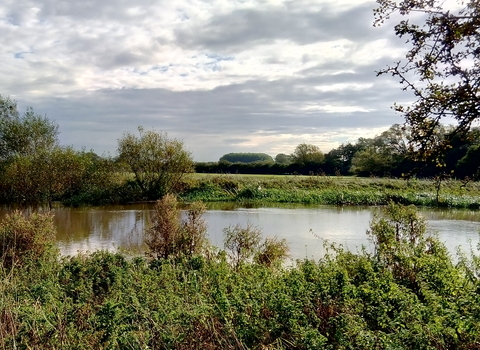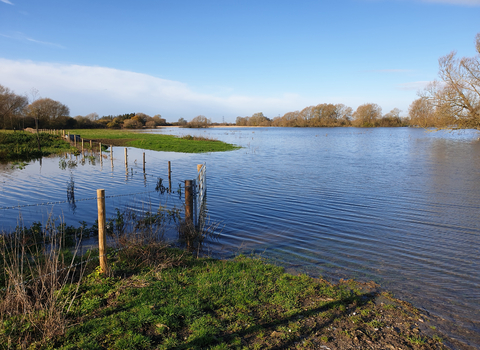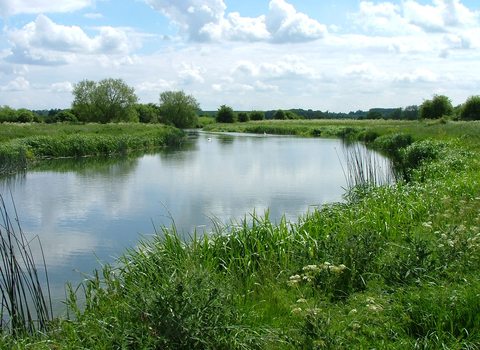In 2017 BBOWT purchased Duxford Old River, a 45-hectare site that has been managed previously as commercial pasture for cattle. Duxford lies adjacent to Chimney Meadows Nature Reserve in Oxfordshire, our largest nature reserve whose fields are part of an ancient landscape, created by the River Thames and shaped by centuries of farming.
Duxford is of great strategic significance as it lies at the heart of the Upper Thames Living Landscape and Conservation Target Area. Our plan for Duxford is to restore the river, floodplain and precious wetland habitats making it a haven for wildlife, complementing the landscape-scale conservation work we have already undertaken at Chimney Meadows since 2003.
Prior to becoming a habitat bank, between 2020 and 2021, a range of Water Environment Grant (WEG ) funded management improvement works were undertaken on site including the creation of a bypass channel to facilitate fish passage along the Thames, and water control structures and scrapes to enable the land to hold more water for longer. But we knew we could do so much more to help drive nature’s recovery on the site, and this is why we decided to make Duxford a habitat bank, so that we could restore biodiversity and fund this through the new Biodiversity Net Gain regulated market.
Duxford Habitat Bank has been allocating BNG units since 2023 to developers who are looking to minimise their environmental impact, and these offsets are formally reported to the Local Planning Authority and recorded onto the Gain Site Register.

View of Duxford showing the poplar plantation
30 Year Vision
Whilst the current biodiversity value of Duxford is low, we are implementing a nature-led management approach to drive the establishment of functioning ecological processes over the next 30 years. We predict a mosaic of key floodplain habitats will be created, such as floodplain wetland mosaic, other neutral grassland, broad-leaved woodland, and mixed scrub. This will create a range of ecological niches in which wildfowl, waders, songbirds and specialist wetland invertebrates can thrive.
Landscape Recovery
Click on the images below to see how the site will change with time.

Floods at Duxford Old River. Photo: Simon Cousins
Ecosystem Services
Duxford Habitat Bank will be delivering so much more biodiversity than what the current Defra metric allows us to measure. Beyond the biodiversity benefits, over 30 years we predict that a number of ecosystem services on the site will improve such as flood regulation, erosion protection, and carbon storage, whilst also encouraging community interaction with nature.
Over the life of the habitat bank we plan to publish monitoring results showing the changes in habitat type and condition, key species populations (such as birds, bats, water voles and insects), the hydrology of the site, changes in nutrient levels, and carbon storage within the soils, as the water levels and habitats change.

Community and Business Engagement
Members of the public can watch the progress of habitat restoration from our Thames Observation Platform which overlooks the land at Duxford. Located on the Thames Path, the hide allows visitors uninterrupted views of the developing habitats and wildlife at Duxford, as well as panoramic views along the Upper Thames.
We are also keen to work with business from all sectors who would like to understand more about their nature-related dependencies and impacts because the natural environment is fundamental to everything we produce, consume, and depend on for our shared prosperity, health and well-being.
Duxford Habitat Bank was officially launched in March 2023, and is providing biodiversity units for developers who are looking to minimise their environmental impacts on-site and meet the planning regulations for BNG. Duxford Habitat Bank is an approved supplier of high integrity biodiversity units and is registered as BGS-020524001, managed and monitored in the public domain according to statutory requirements of Natural England, Defra, South Oxfordshire and the Vale of White Horse District Council.
To find out more, including options and costs for BNG, please contact BNG@bbowt.org.uk










